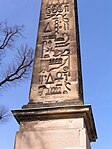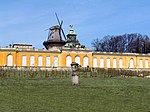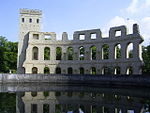Neptune Grotto

The Neptune Grotto (German: Neptungrotte) close to the Obelisk entrance in Sanssouci Park, Potsdam, was created by Frederick the Great between 1751 and 1757 to beautify the park. Built following plans by Georg Wenzeslaus von Knobelsdorff it arose as a representation of the revived interest in garden architecture. The grotto ought to have been a component of the numerous fountains of the park, which did not function at that time, owing to a lack of technical knowledge. The trident wielding god of the sea, Neptune, establishes a relationship to water. The conches on the sides, arranged into the shape of waterfalls and the great shell inside, made from many real shells, are a characteristic theme of Rococo.
Excerpt from the Wikipedia article Neptune Grotto (License: CC BY-SA 3.0, Authors, Images).Neptune Grotto
Schopenhauerstraße, Potsdam Brandenburger Vorstadt
Geographical coordinates (GPS) Address External links Nearby Places Show on map
Geographical coordinates (GPS)
| Latitude | Longitude |
|---|---|
| N 52.4033333333 ° | E 13.0422222222 ° |
Address
Neptungrotte
Schopenhauerstraße
14469 Potsdam, Brandenburger Vorstadt
Brandenburg, Germany
Open on Google Maps











